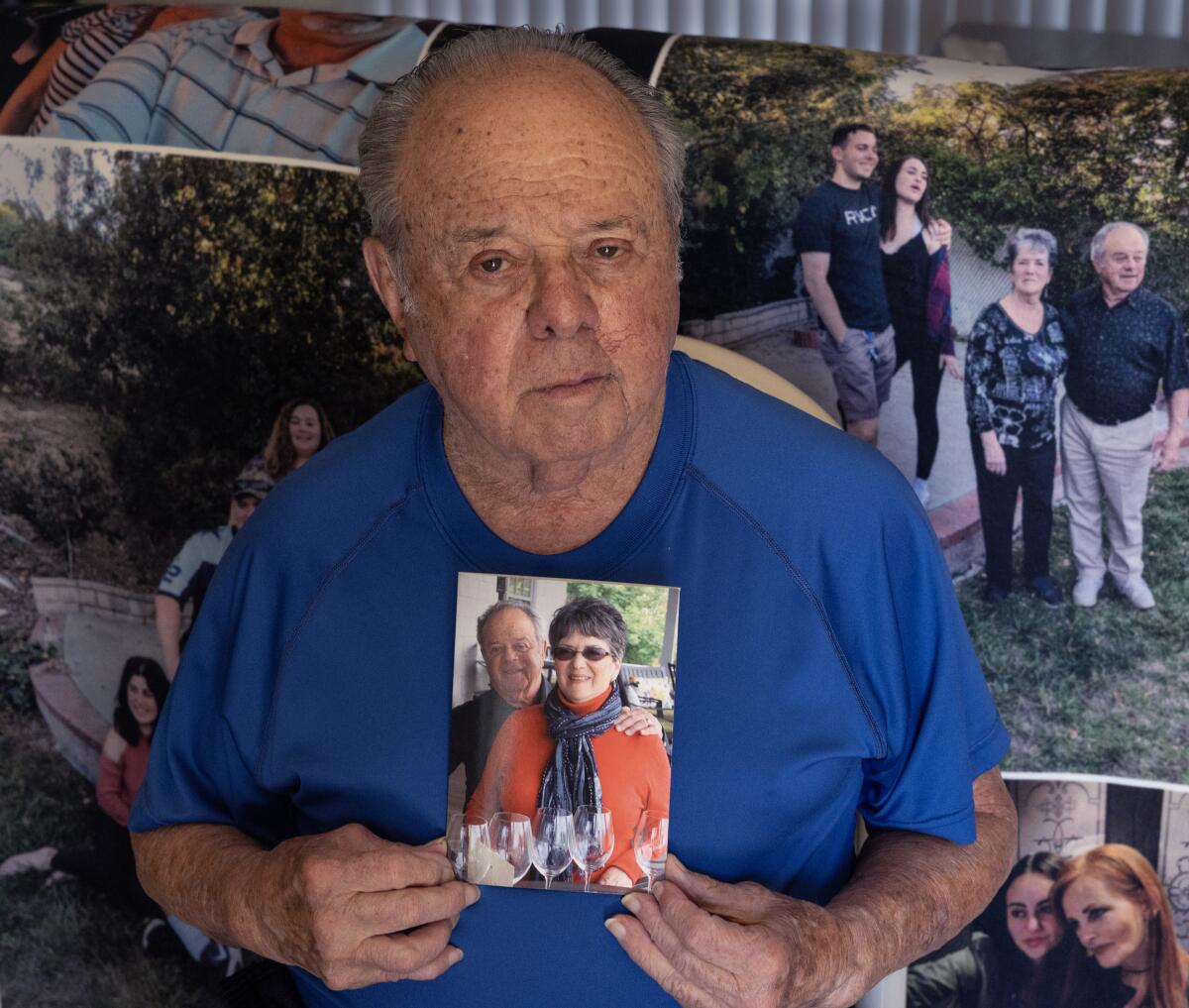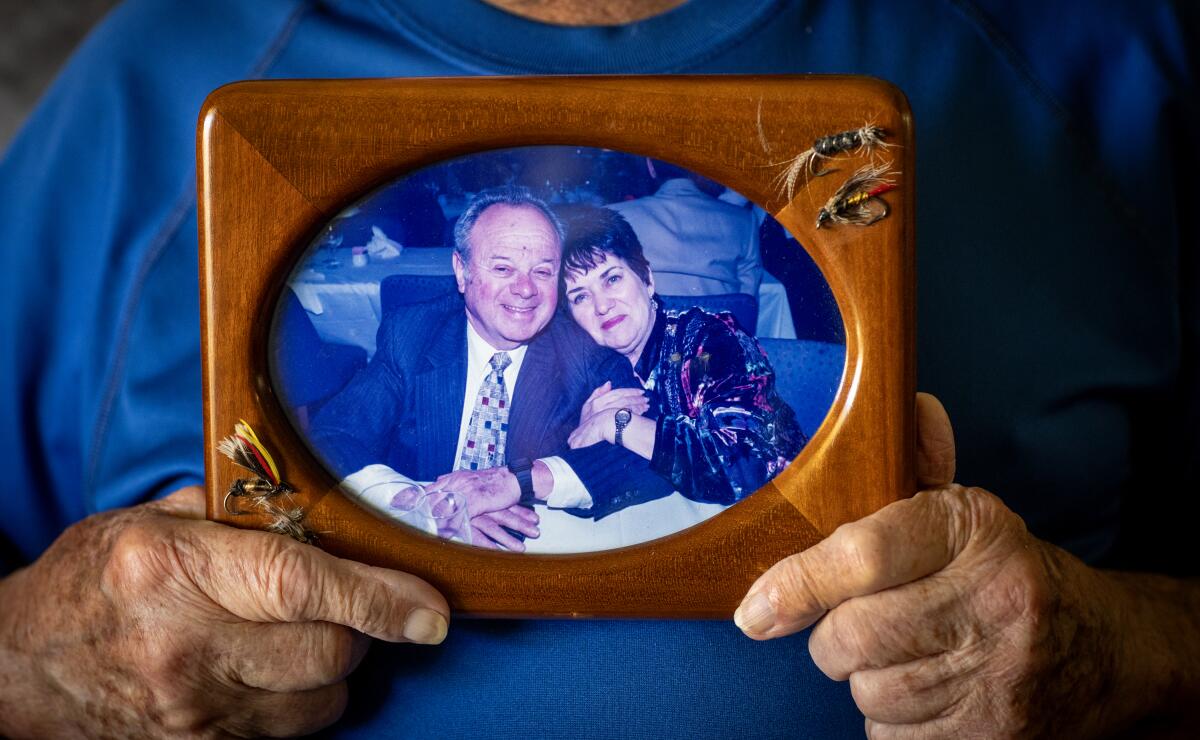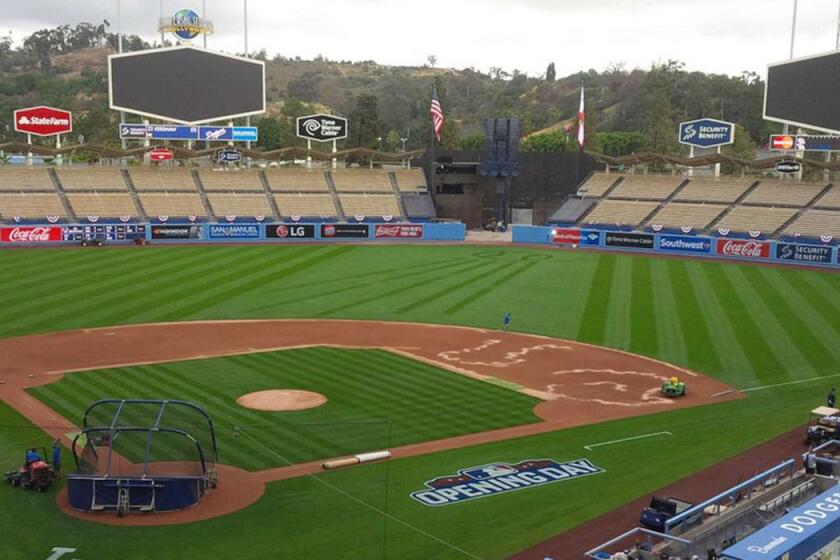Five years after his wife was killed by a foul ball at Dodger Stadium, Erwin Goldbloom still mourns

- Share via
Five years later, the foul ball still screams, its journey still silences, an impact eternal.
Every night before going to bed, Erwin Goldbloom walks to the office of his quiet Camarillo home and taps up a YouTube video on his computer.
It is the sound of Nat King Cole singing, “Fascination.”
It was their song.
“She was beautiful,” he says.
Five years ago, Linda Goldbloom accompanied her husband of 59 years to Dodger Stadium for a Saturday night game against the San Diego Padres.
She had the best seat. She had the perfect view. Loge level, third row, on the right side of home plate, Erwin on the aisle next to her, the batters directly in front of her.
She wore blue. She cheered loudly. She stood and sang at the seventh-inning stretch. She sat back down and focused on the field as a one-run duel crept into the start of the ninth inning.
Then a foul ball hit her in the face and killed her.
Five years later, Erwin, 90, serenades his late wife’s spirit with a nightly love song while pondering a web of endless cruelty.
Of the 53,528 people at Dodger Stadium that night, why did the ball find her? How could a game that gave her so much life so directly cause her death?
And why was the protective netting so low?
The pain was compounded when the Dodgers initially didn’t acknowledge her death, and there was no public recognition of it until Erwin’s daughter, Jana Brody, contacted ESPN nearly six months later.
In fact, even though it was only the second death by foul ball in major-league history, there’s a good chance many are just hearing about it now.
Five years later, her widowed husband lives with it daily.
“Life isn’t fair,” Erwin says, choking back tears. “I wish I had been in her seat.”
It was the final night of their 10-game season-ticket allotment. It was potentially the final inning of that final game. They were so close to going home.
In typical Los Angeles fashion, many other spectators already had headed for the parking lot, but not the Goldblooms.
“We never left a game before it ended,” Erwin said. “We’re true fans.”
They were, indeed, die-hards, with partial season tickets for more than 20 years and a Dodgers history that dated to their courtship days in the Coliseum.
They attended World Series games, playoff games and even Sandy Koufax’s perfect game. They unconditionally loved the Dodgers and built a life draped in blue.
“My mom would love packing a lunch and going to the games,” Jana recalls. “It was a fun, easy time to be with dad.”
Linda worked for CBS radio and later in clothing stores; Erwin coached wrestling and taught health and physical education at Pierce College while also becoming a renowned wrestling referee. They had built a strong family life together in West Hills with three children and seven grandchildren.

“I was pissed off because it was like the Dodgers were saying, ‘We’re above this, we don’t want people to know because they won’t come to the game.’ To them it was just another incident.”
— Erwin Goldbloom, on his wife dying after being hit by a foul ball
After they both retired, Dodgers games were their entertainment, their date nights, their popcorn-scented bond.
The Saturday of Aug. 25, 2018 was one such occasion. They used the last of their tickets for the game against the Padres. They were accompanied by Erwin’s brother and sister-in-law, Michael and Eve Goldbloom.
Erwin and Linda, 79, sat in the third row, Michael and Eve sat directly behind them.
When the game reached the ninth inning, the Dodgers led 3-2 with Kenley Jansen on the mound. It was typical Jansen hold-your-breath time. The idle conversation between the couples ceased.
“We know baseball, we were focused on watching the game, we weren’t turning around chatting,” Eve recalls. “I saw exactly what happened, and I remember it like it was yesterday.”
The inning started with 6-foot-5, 285-pound Franmil Reyes, a hulking giant who had homered in his previous plate appearance.
Jansen started him out with a ball, then a called strike, then another ball.
Then Reyes swung from his heels and caught the edge of the pitch and sent the ball blistering back over the netting behind home plate.
There was no time to react. There was no time to move. In an instant, the ball was smashing against Linda’s right cheek, and she immediately slumped in her seat.
Sitting directly behind her, Eve immediately knew something was terribly wrong.
“That ball came back like a bolt of lightning, a white bolt of lightning,” she remembers. “I have sat in nearly every seat in that stadium and I’ve never seen a ball coming back into the stands with that kind of speed.”
The ball hit Linda so hard, it ricocheted off her face to the row above her, bounced off Michael’s chest, and then clattered up several rows.
“Linda never stood a chance,” Eve remembers. “I’m like, ‘Oh my God, it hit her in the head.’”
Erwin quickly stood and leaned over her.
“Are you OK?” he asked.
“I am not OK,” she said.
After a lifetime together, it was their last conversation.
By the time medical personnel arrived, Linda couldn’t walk, so two emergency medical technicians carried her up the aisle and into an ambulance and rushed her to what is now Los Angeles General Medical Center.
Erwin rode in the front seat. He didn’t hear her vomiting. He didn’t see the medics insert a breathing tube. He initially couldn’t recognize the dire nature of her condition. Foul balls aren’t really killers, are they?
“I thought she was going to go in, get checked out, sign a few papers, and we were going to go home,” he recalls.
She never made it home. She underwent emergency brain surgery and never regained consciousness. She died four days later.
The Los Angeles County coroner’s report listed the cause of death as “acute intracranial hemorrhage due to history of blunt force trauma.” It cited the foul ball as the reason for the injury.
The family sent an email to relatives and friends announcing her death while noting that “the end came suddenly by a foul ball at Dodgers Stadium.”
Death by foul ball. The coroner’s report was clear. The family didn’t try to hide it. But nobody seemed to want to acknowledge it.
The Dodgers did not reveal the death for nearly six months, later telling the New York Times, “the Dodgers generally do not make reports of accidents that take place at Dodger Stadium. We avoid doing so out of respect for the privacy of the persons involved and their families.”
The media had no idea what was happening and did not mention the incident in game reports, noting only that after the Padres’ Austin Hedges tied the score with a home run in the ninth, the Dodgers eventually won 5-4 in the 12th. End of story.
If reporters had known of the eventual death, it would have been big headlines, not only out of respect for Linda’s life, and not only because it was only the second time in Major League Baseball history that a fan died after being struck by a foul ball … but also because the first death also was at Dodger Stadium. Alan Fish, 14, died in 1970 after he was hit by a foul ball off the bat of Manny Mota.
“People needed to know what happened to Linda, and the dangers of sitting in the stands, yet it was ignored, and I couldn’t understand it,” Erwin says. “Why didn’t the Dodgers just say a woman died at a game last night? Isn’t that something they should do?”
Five years later, the anger remains.
“I was pissed off because it was like the Dodgers were saying, ‘We’re above this, we don’t want people to know because they won’t come to the game.’” he says. “To them it was just another incident.”
Nearly six months later, equally upset by the lack of public understanding and certain that the tragedy could have been prevented with more protective netting, Brody made her mother’s death public through ESPN’s William Weinbaum.
The Dodgers announced Friday that additional protective netting down the foul lines will be installed at Dodger Stadium by Monday when the club returns home.
“Every time I told her story to people, their mouths would fall open, and they would ask if the Dodgers did anything,” she recalls. “They didn’t, and that had to change.”
When confronted with the death, besides the statement to the New York Times, the Dodgers also told ESPN, “Mr. and Mrs. Goldbloom were great Dodgers fans who regularly attended games. We were deeply saddened by this tragic accident and the passing of Mrs. Goldbloom. The matter has been resolved between the Dodgers and the Goldbloom family. We cannot comment further on this matter.”
When contacted for this five-year anniversary story, the Dodgers again declined further comment.
The family couldn’t successfully sue the Dodgers because of the Baseball Rule, a legal term that holds that teams are not responsible for injuries that occur from a foul ball. They eventually settled with the team for a confidential amount, then Brody went on a publicity blitz aimed at forcing all teams to expand and heighten the protective netting.
At the time of the accident, it was the first season that all 30 teams had installed netting from behind home plate to the far end of the dugouts. But it wasn’t enough to save Linda’s life, so Jana and Erwin kept pushing through media interviews until teams began increasing the height and length of the netting.
Finally, a year after Linda’s death, the Dodgers added eight feet to the netting behind home plate and above both dugouts, enough to have saved Linda’s life. They also extended the netting beyond the dugouts and to the elbow bend in front of the field level seats. Since then, every team has extended the netting and all minor league teams are required to install netting by the start of the 2025 season.
Brody, whose book “Sit Behind The Nets!” chronicles her family’s tragedy and its ensuing quest, only wishes change had not come so slowly.
Tommy Lasorda’s longtime assistant cherishes the experiences he shared with the Dodgers legend: ‘All I had to offer him was loyalty and love’
“I’m just mad that it’s taken so long to get the word out,” she says. “And now they’re saying minor league baseball has until 2025? That’s three years’ worth of injuries.”
Still, five years later, it is Erwin’s only solace.
“Every time I see a foul ball hit into a net, I think, I just saved somebody’s life,” he says.
He still watches baseball, only he does it alone, from his couch. He surrendered his season tickets and will never again set foot in Dodger Stadium, hauntingly located only 10 miles from where his wife is buried.
“I can’t go back there. Too hard. Too many memories,” he says.
But he doesn’t blame the players. He still cheers for the Dodgers on television. And he knows Linda would be cheering with him.
“She’d go to bed early and I’d stay up and watch the end of the games, but I knew she was always there,” he says. “She was always a Dodger fan.”
Five years later, Erwin’s summer evenings no longer end with Joe Davis and Orel Hershiser, but with Nat King Cole, memories of his late wife forever more powerful than any foul ball.
“We loved that song,” he says.
More to Read
Are you a true-blue fan?
Get our Dodgers Dugout newsletter for insights, news and much more.
You may occasionally receive promotional content from the Los Angeles Times.












